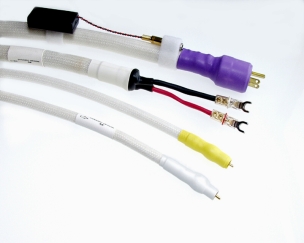You are reading the older HTML site
Positive Feedback
ISSUE
24
dynamic design
THB Nebula interconnects
as reviewed by Robert H. Levi

|
|
|
You are reading the older HTML site
Positive Feedback
ISSUE
24
dynamic design THB Nebula interconnects as reviewed by Robert H. Levi
|
|
|
If I told you there was a $4000 pair of interconnects available for $2500, would you dash out and buy it? We are dealing with the stratosphere of top cable designs and performance here. If you are willing to spend serious money on interconnects, you should consider Dynamic Design's new top-of-the-heap model, the THB Nebula (www.dynamicdesignav.com) . Though expensive at $2500 for a one-meter pair, my oh my do they sound open, airy, clean, and alive. They are unsurpassed in their lack of smear or grain by any other cables I know of at this price. Part of the secret of the Nebulas is their bi-metal construction, the composition of which is not revealed in Dynamic Design's white paper. Their dielectric is mostly air. Shielding is multi-layered. The cables have ultra-low capacitance and they are very stiff. This helps maintain phase integrity and a constant dielectric at all frequencies. The RCAs are beefy, top-grade, solid silver connectors with massive strain relief. The size of these connectors eliminates their use on mass-market gear, which is likely to have closely-spaced RCA jacks. The Nebulas require 80 hours of break-in. I have recently been amazed by the exotic materials used in interconnects. These new combinations often produce good results, but the Nebulas do not sound like my gold, silver, palladium, copper, or light-fiber references. They sound open like gold, powerful like copper, fabulously detailed like palladium, and uncolored like fiber. They are not quite as fast as silver, but they sound significantly less dry and more natural. Their imaging is almost as solid as that of my best cables, not that it matters. Their ultra clarity and amazing beauty of tone transported me to a place I knew was right as rain. The clarity starts in the deep bass and goes all the way to the top octaves. I can only think of two other cables that sound as clear over this much of the frequency range, but both are significantly more expensive. They may be a bit less rich than top copper interconnects, but they are perfectly appropriate for use with the finest gear around. Dynamic Design claims a 7dB reduction in noise over conventional cables, and I believe it! If you are an audiophile, you crave as much transparency and “quietude” as you can get. The Nebulas deliver. I listened intently to the Nebulas during two long review sessions totaling at least four months, trying to identify any additions (particularly edginess or emphasis) or subtractions. I tried the Nebulas in three different systems, featuring solid-state, SET, and push/pull tube amps. My entire cable inventory was thrown against the Nebulas, as were those of several audiophile friends. Nothing costing under $3300 truly bested them. Nothing exposed significant or important flaws. Nothing made me want to pull them from the system. If I have a quibble, it's minor—the Nebulas lack a bit of warmth. I may be so used to the sound of copper cables, with their added traction and lusher tonality, that I miss it in the sound of exotic interconnects like the Nebulas. A touch more textural warmth would make the Nebulas almost perfect, and we could not have that happen—I'd be out of a job. Now that I think about it, I'd also like a bit more depth retrieval. Quite a wish list. Maybe over another year or so I'll hear other small flaws. Maybe not. I love jazz through the Nebulas, and vocals of all kinds. Their fantastic clarity lets the textures of the human voice pop into the room. Bells, xylophones, chimes, and so on are downright ethereal. Snares and cymbals are focused to perfection. I hesitate to say that these cables are best with jazz or pop. It's just that their ability to remain unflustered and uncongested regardless of the intensity of the performance complemented Miles more than Mozart. Large-scale choral music was also rendered magnificently and realistically. No other cables at the price beat the Nebulas at resolving massed voices. This is not your father's richly warm sound. This is X-ray definition, black backgrounds, and music as recorded and played back on your gear. The Nebulas, unlike many other top brands, make lousy tone controls. They reveal. They don't fix. I want to emphasize that the Nebulas' clarity of definition and tone occur at ALL audible frequencies. Their 3-D effect is instantly recognizable. The system speaks with one voice. If you listen to a live acoustic recording, you will hear the venues and performers. This is about as realistic as it gets in two-channel. The Nebulas bring the performance into the room without becoming relentless or adding glare. The experience is unquestionably front-hall. There is no rounding of leading transients or leveling of dynamics. Also, the Nebulas have a vanishingly low grain structure. I have no clue what metals are being used. I hesitate to call this secret formula a breakthrough, but it certainly adds life to the listening experience. I understand from Bill Artope, Dynamic Design's west coast partner (and a member of the Los Angeles and Orange County Audio Society), that the THB Nebulas will be eclipsed by a no-holds-barred assault on the state of the art from Dynamic Design called the TBK Nebula, but that the THB Nebulas will remain in the line. If the TBKs deliver more definition and musicality than the THBs, I'll need smelling salts. Meanwhile, the Dynamic Design THB Nebulas join the ranks of ne plus ultra interconnect designs available to deep-pocketed audiophiles searching for musical perfection. Robert H. Levi Recordings used in the evaluation of these cables included:
THB Nebula interconnects
Dynamic Design
|